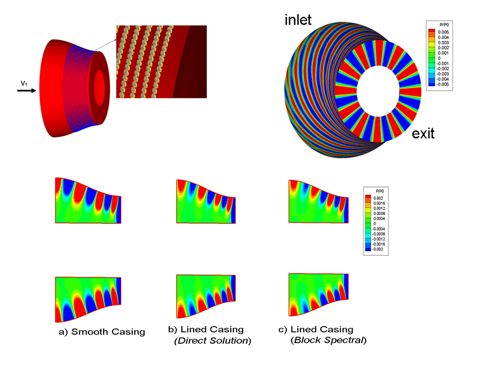Oxford Thermofluids Institute | Research - Research Groups: CFD Group, CFD Method Development

CFD Method Development
Unstructured and multi-block structured mesh solvers
Multigrid Upwind Navier-Stokes Solver on Adaptive Unstructured Meshes
An unstructured flow solver with adaptive mesh refinement and multigrid acceleration is developed (Zheng and He 2001) to efficiently compute two-dimensional inviscid and viscous steady flows about complex configurations. High resolution is achieved by using a 2nd order upwind scheme coupled with adaptive mesh refinement. An aspect-ratio adaptive multigrid method originally developed for relaxing the time step restriction in unsteady flow computations on structured meshes (He 1993) is implemented to effectively accelerate the solution convergence of the explicit time-marching in the near wall regions with high aspect mesh ratios. The following numerical examples illustrate the capabilities of the adaptive refinement for capturing high gradient regions with shock waves for a transonic airfoil, and wake and large scale separation for low pressure turbine cascade at large negative incidence.
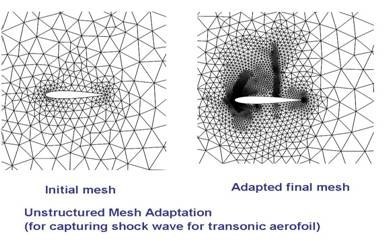
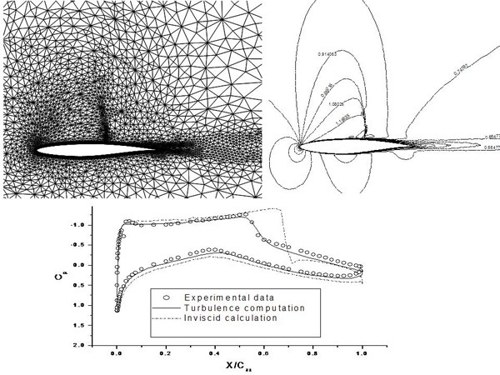
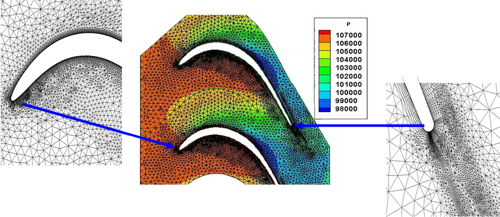
Fig 2. Computation of Turbulent Flow around Low-Pressure Turbine Blades (large scale flow separation on pressure surface under a negative incidence)
Multi-Block Structured Mesh Solutions of the Navier-Stokes Equations
A multi-block solver has been developed (He, 1996), aimed at taking advantages of both the flexibility of the unstructured mesh in local refinement and he simplicity and efficiency of direct structured mesh. The example of the multi-block mesh for the low-pressure turbine cascade is shown below.

Fig 3. Flow around Low Pressure Turbine Blades (multi-block solver)
Fourier modelling for nonlinear steady and unsteady aerodynamics
Fourier Model of Nonlinear Flows
The starting point of a Fourier modelling is the recognition that a nonlinear periodic flow distribution (the periodicity can be in time and/or in space) can be expressed by a temporal and/or spatial Fourier series. In many practical engineering situations, very good approximations can be obtained by truncated Fourier series with a very small number of low order harmonics.
Fourier ‘Shape Correction’ for Single–Passage Time-Marching Solution
The Fourier modelling approach to nonlinear flows was proposed in 1990 for time-marching solutions of unsteady turbomachinery flows (He 1990). This was the first Fourier method for turbomachinery. The objective at the time was to enable an unsteady flow solution to be carried out in a single blade passage domain but without requiring a large amount of computer meomory, as in the Erdos’s Direct Store method. The main ingredient is to carry out the temporal Fourier transform at the ‘periodic boundaries of the single blade passage domain. Then the Fourier harmonics (temporal shape) are used to correct the corresponding boundaries according to the phase shift periodicity. The method was then called ‘Shape Correction’. he validity of the single passage Shape-Correction method can be examined by comparing with the direct multi-passage solution. It was shown that the Fourier modelling as implemented in the Shape-Correction can capture flow disturbances and responses with large nonlinearity (e.g. a large scale shock oscillation in fan blade passage under an inlet distortion of long circumferential wave length, Fig.1 (Li and He 2001).
Given only 3-5 harmonics were required for capturing sufficiently accurately the temporal variation, the computer memory requirement is very low compared to the Erdos’s Direct Store approach. A key advantage of splitting flow components represented by Fourier harmonics is the ability in dealing with multiple disturbances with distinctive frequencies (He 1992). The generalised shape correction has been applied to unsteady flows in multi-rows (IGT-rotor-stator) with vibrating rotor blades for optimization of intra-row gap effects on both aerothermal performance and flutter stability, Fig.2 (Li and He 2005).
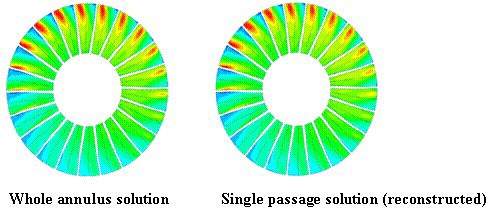
Fig.1 NASA rotor67 under inlet distortion (stagnation pressure contours)
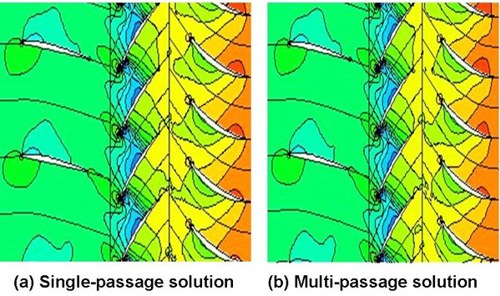
Pressure contours of IGV-Rotor-Stator Interaction
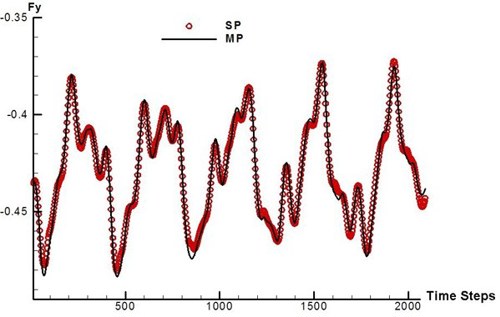
Time History of Force on Vibrating Rotor blade in IGV-rotor-stator configuration (SP-Single passage, MP-Multi-passage)
Nonlinear Harmonic Approach (frequency domain Fourier model)
A conventional frequency-domain time-linearised solution method offers a significant advantage in solution efficiency compared to the nonlinear time-domain method. The restriction is of course that the unsteady disturbances need to be small perturbations to a steady state with negligible effects on the base steady flow. Consequently with a given steady state, we only need to solve a time-independent harmonic equation for one harmonic unsteady disturbance. The solution to the complex number amplitude field for the amplitude and phase angle of the unsteadiness is equivalent to solving two steady flow fields. To relax the fundamental linear assumption while taking advantage of the high solution efficiency, a nonlinear harmonic method was proposed (Ning and He, 1998). Similarly to the time-domain Fourier model, the unsteadiness is represented by the Fourier series. But now each harmonic will be balanced (‘harmonic balancing’) respectively in the nonlinear flow equations. Consequently, for a Fourier series retaining N harmonics, we will have 2N equations for the complex harmonics. In addition, the time-averaged flow will now be different from the steady flow due to the added deterministic stresses. So in total we have 2N+1 steady-like flow equations, which are solved simultaneously to reflect the interactions between the unsteady harmonics and the time mean flows. The interactions among the harmonics are included in a more complete nonlinear harmonic formulation by Hall’s harmonic balance formulations.
The nonlinear harmonic approach have been extended to effectively solve rotor-rotor/stator-stator interactions in multistage turbomachines (He et al 2002).
Recently efforts have been made to harness nonlinearity to stabilize the harmonic solution at highly loaded conditions with large scale flow separations (He, 2008).
Spatial Fourier Spectral Model for Non-Axisymmetric Flows
In many cases of practical interest, large scale steady and/or unsteady flow disturbances develop in large cylindrical domains (e.g. intake, exhaust ducts, rotor disk cavities). The circumferential domain truncation similar to the single-passage method is difficult without a known circumferential wave length. Thus, a computational domain to cover the whole 360° circumference would be necessary.
In these cases with a large circumferential domain, a circumferential Fourier spectrum can be introduced to achieve an efficient solution. The model can be quite simply implemented in an existing time-marching solver, and the validity has been demonstrated for an intake duct case subject to a cross-wind, and a case of acoustic pressure wave corresponding to fan tone noise propagated in a distorted duct (He, 2005, 2006).
Recently the spatial Fourier model has been applied to analysis of self-excited coherent unsteady flows and convective heat-transfer in rotating disk cavities.
Circumferential flow Angle (exit plane from an intake duct, subject to 10 cross wind)
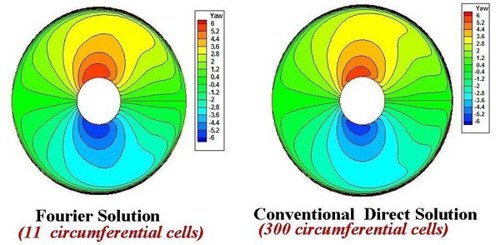
Multi-scale Method (Block-Spectral Model)
For many problems in aerospace and power generation industries, there are very different length scales. The fine (micro) scale features of a huge number of geometrically largely similar regions collectively interact with globally large (macro) scale phenomena. Examples include flows through porous medium, effusion film-cooling through many holes of a tiny size, acoustical liners for duct noise reduction, and surface mini-scale treatment for flow control (e.g. dimples etc). The traditional treatment of this kind of problems would be to use empirically based models to count for the effects of the small scale features and to solve an up-scaled problem on a coarse mesh. The generality of the solutions following this kind of approaches are of course limited by the very empirical nature of these fine-scale models.
Here we are interested in developing a new multi-scale methodology, called ‘Block-Spectral Method’. The main intended attribute of the new approach is that the same numerical discretization scheme and integration method are used for both the coarse (macro) and fine (micro) scales, so that the numerical resolution is consistently and completely dictated by the mesh scales. A blocking of the fine resolution domain is introduced to facilitate the two basic but competing requirements:
- high resolution for fine scale flow features
- avoidance of having to have fine meshes for a large domain.
The block spectral approach can be simply illustrated by comparing a direct solution and a block spectral solution, as shown in Fig.1. The method has been shown to lead to a significant gain in solving micro-scale problems (up to 102 reduction of degrees of freedom). An important perspective is that the methodology would enable to resolve the kind of the micro-scale problems currently intractable.
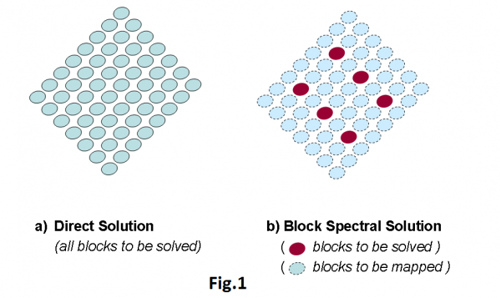
Dimpled Surface
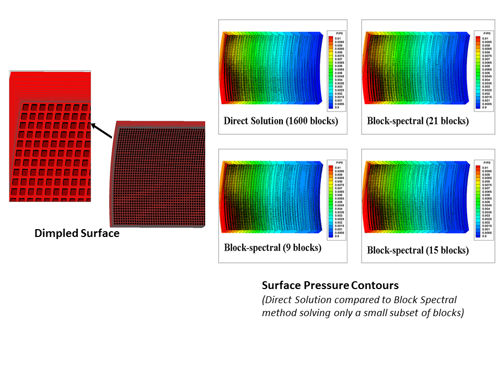
Unsteady Effusion Cooling (~1000 micro holes)
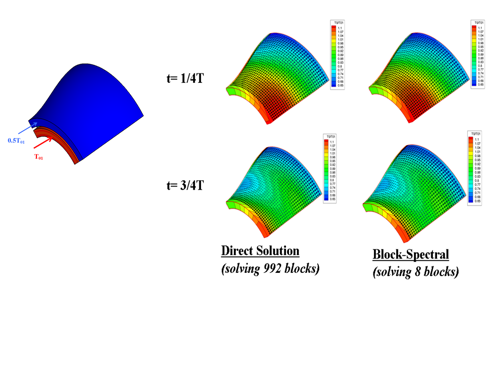
Intake Duct with Acoustical Liner (micro cavities)
